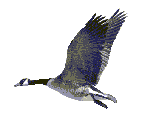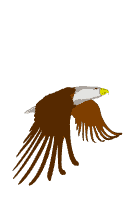|
|
|
|
The Eagle and the Goose Print and color your own goose picture:
Name Giveaway Here is a poem entitled "Name Giveaway" by Nez Perce tribal member Phil George
about the non-Indian names that white teachers gave him. It is being used in the Idaho Skylights program putting
poetry and art on school buses. That teacher gave me a new name ... again.
Native American Lore
Lessons from Geese
 The wintry
winds had already begun to whistle and the waves to rise when the Gander and his mate gathered their half- grown
brood together on the shore of their far northern lake.
The wintry
winds had already begun to whistle and the waves to rise when the Gander and his mate gathered their half- grown
brood together on the shore of their far northern lake.
"Wife," said he, "it is now time to take the children southward, to the Warm Countries which they
have never yet seen!"
Very early the next morning they set out on their long journey, forming a great "V" against the sky in
their flight. The mother led her flock and the father brought up the rear, keeping a sharp lookout for stragglers.
All day they flew high in the keen air, over wide prairies and great forests of northern pine, until toward evening
they saw below them a chain of lakes, glittering like a string of dark-blue stones.
 Swinging round in a half circle, they dropped lower and lower, ready to alight and rest upon the
smooth surface of the nearest lake.
Swinging round in a half circle, they dropped lower and lower, ready to alight and rest upon the
smooth surface of the nearest lake.
Suddenly their leader heard a whizzing sound like that of a bullet as it cuts the air, and she quickly gave the
warning: "Honk! honk! Danger, danger!" All descended in dizzy spirals, but as the great Eagle swooped
toward them with upraised wing, the goslings scattered wildly hither and thither. The old Gander came last, and
it was he who was struck!
 "Honk, honk!" cried all the Geese in terror, and for a minute the air was full of soft
downy feathers like flakes of snow. But the force of the blow was lost upon the well-cushioned body of the Gander,
he soon got over his fright and went on his way southward with his family, while the Eagle dropped heavily to the
water's edge with a broken wing.
"Honk, honk!" cried all the Geese in terror, and for a minute the air was full of soft
downy feathers like flakes of snow. But the force of the blow was lost upon the well-cushioned body of the Gander,
he soon got over his fright and went on his way southward with his family, while the Eagle dropped heavily to the
water's edge with a broken wing.
There he stayed and hunted mice as best he could from day to day, sleeping at night in a hollow log to be out of
the way of the Fox and the Weasel. All the wit he had was not too much whereby to keep himself alive through the
long, hard winter.
 Toward spring, however, the Eagle's wing had healed and he could fly a little, though feebly. The
sun rose higher and higher in the blue heavens, and the Geese began to return to their cool northern home. Every
day a flock or two flew over the lake; but the Eagle dared not charge upon the flocks, much as he wished to do
so. He was weak with hunger, and afraid to trust to the strength of the broken wing.
Toward spring, however, the Eagle's wing had healed and he could fly a little, though feebly. The
sun rose higher and higher in the blue heavens, and the Geese began to return to their cool northern home. Every
day a flock or two flew over the lake; but the Eagle dared not charge upon the flocks, much as he wished to do
so. He was weak with hunger, and afraid to trust to the strength of the broken wing.
One fine day a chattering flock of Canadians alighted quite near him, cooling their glossy breasts upon the gently
rippling wave.
 "Here, children," boasted an old Gander, "is the very spot where your father was
charged upon last autumn by a cruel Eagle! I can tell you that it took all my skill and quickness in dodging to
save my life. Best of all, our fierce enemy dropped to the ground with a broken wing! Doubtless he is long since
dead of starvation, or else a Fox or a Mink has made a meal of the wicked creature! "
"Here, children," boasted an old Gander, "is the very spot where your father was
charged upon last autumn by a cruel Eagle! I can tell you that it took all my skill and quickness in dodging to
save my life. Best of all, our fierce enemy dropped to the ground with a broken wing! Doubtless he is long since
dead of starvation, or else a Fox or a Mink has made a meal of the wicked creature! "
By these words the Eagle knew his old enemy, and his courage returned.
"Nevertheless, I am still here!" he exclaimed, and darted like a flash upon the  unsuspecting
old Gander, who was resting and telling of his exploit and narrow escape with the greatest pride and satisfaction.
unsuspecting
old Gander, who was resting and telling of his exploit and narrow escape with the greatest pride and satisfaction.
"Honk! honk! " screamed all the Geese, and they scattered and whirled upward like the dead leaves in
autumn; but the Eagle with sure aim selected the old Gander and gave swift chase. Round and round in dizzy spirals
they swung together, till with a quick spurt the Eagle struck the shining, outstretched neck of the other, and
snapped it with one powerful blow of his reunited wing.
Do not exult too soon; nor is it wise to tell of your brave deeds within the hearing of your enemy.
She never even had feasts or a giveaway!
Still I do not know what "George" means;
And now she calls me "Phillip."
TWO FLOCKS OF GEESE LIGHTING UPON STILL WATERS
Must be a name too hard to remember.
.jpg) |
FACT 1: | As each Goose flaps its wings it creates an "uplift" for the birds that follow. By flying in a "V" formation, the whole flock adds 71% greater flying range than if each bird flew alone. |
| LESSON: | People who share a common direction and sense of community can get where they are going more quickly and easily because they are traveling on the thrust of one another. | |
.jpg) |
FACT 2: | When a Goose falls out of formation, it suddenly feels the drag and resistance of flying alone. It quickly moves back into formation to take advantage of the lifting power of the bird immediately in front of it. |
| LESSON: | If we have as much sense as a Goose we stay in formation with those headed where we want to go. We are willing to accept their help and give our help to others. | |
.jpg) |
FACT 3: | When the lead Goose tires, it rotates back into the formation and another Goose flies to the point position. |
| LESSON: | It pays to take turns doing the hard tasks and sharing leadership. As with Geese, people are interdependent on each other's skills, capabilities and unique arrangements of gifts, talents or resources. | |
.jpg) |
FACT 4: | The Geese flying in formation honk to encourage those up front to keep up their speed. |
| LESSON: | We need to make sure our honking is encouraging. In groups where there is encouragement, the production is much greater. The power of encouragement (to stand by one's heart or core values and encourage the heart and core of other) is the quality of honking we seek. | |
.jpg) |
FACT 5: | When a Goose gets sick, wounded or shot down, two Geese drop out of formation and follow it down to help and protect it. They stay with it until it dies or is able to fly again. Then, they launch out with another formation or catch up with the flock. |
| LESSON: | If we have as much sense as Geese, we will stand by each other in difficult times as well as when we are strong. |

|
Species: Scientific name : Brata canadensis Common Name: Canada Geese
Range: The Canada Geese are natives to North America. They range from the Arctic coast
of northeastern Asia and of North America to lower California and Mexico. True Geese of the World A couple of Canada goslings |
![]()
|
|
| Canku Ota is a free Newsletter celebrating Native America, its traditions and accomplishments . We do not provide subscriber or visitor names to anyone. Some articles presented in Canku Ota may contain copyright material. We have received appropriate permissions for republishing any articles. Material appearing here is distributed without profit or monetary gain to those who have expressed an interest. This is in accordance with Title 17 U.S.C. section 107. |
|
Canku Ota is a copyright of Vicki Lockard and Paul Barry. |
|